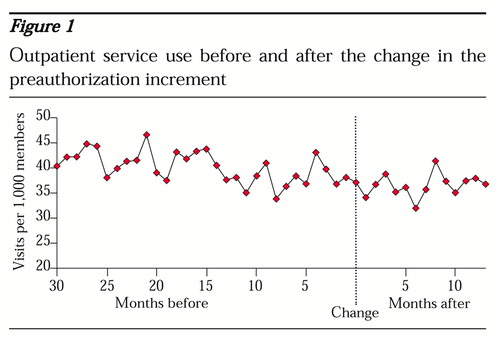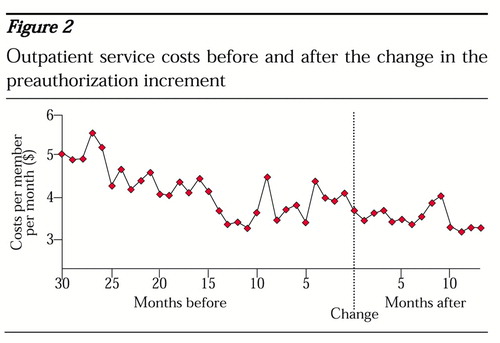Datapoints: Effects of Changing From Five to TenPreauthorized Outpatient Sessions
Use of preauthorization by managed behavioral health organizations is designed to reduce unnecessary treatment and spending and to improve the appropriateness of treatment. Two studies have shown that the number of sessions typically preauthorized—the preauthorization increment—is directly related to the duration of outpatient treatment and therefore to outpatient spending (1,2).
In July 1998 United Behavioral Health (UBH), a large national managed behavioral health organization, began preauthorizing ten outpatient sessions rather than five for persons in the State of Ohio Employer Group. UBH manages more than 145,000 covered lives for the Ohio group, and about 7.2 percent of adults use outpatient mental health services.
Using an interrupted time series auto regression integrated moving average (ARIMA) model with a pre-post covariate (3), outpatient utilization and costs during the five-visit period were compared with those for the ten-visit period, controlling for previous trends in utlization and seasonal effects.
Figure 1 shows monthly use of outpatient services before and after the change. Results of the ARIMA model found no significant differences in rates of use between the periods (t=.28, df= 42, p>.10). This finding suggests that the level and trend in monthly utilization rates were not affected by the change in the preauthorization increment.
Figure 2 shows monthly costs before and after the change. Results of the ARIMA also found no significant differences in costs between the periods (t=-.78, df=42, p<.10). Although Figure 2 shows a negative trend in total monthly mental health costs, results suggest that the trend was unrelated to the change in the increment.
In contrast to other studies (1,2), this study suggests that decreasing the intensity of outpatient care management may not result in higher utilization and costs.
The employer group in the study had a stable utilization history and a well-established provider network. The results therefore might not be generalizable to dissimilar populations. The findings should encourage managed behavioral health organizations to develop an empirical base for their care management policies and explore the potential benefits of reducing the intensity of care management, such as lower operational costs and improved relationships with providers and beneficiaries.
Dr. Compton and Dr. Burns are affiliated with the developmental epidemiology and services effectiveness research program at Duke University Medical Center, Box 3454, Durham, North Carolina 27710 (e-mail, [email protected]). Dr. Cuffel and Dr. Goldman are with United Behavioral Health in San Francisco. Harold Alan Pincus, M.D., and Terri L. Tanielian, M.A., are coeditors of this column.

Figure 1. Outpatient service use before and after the change in the preauthorization increment

Figure 2. Outpatient service cost before and after the change in the preauthorization increment
1. Howard RC: The sentinel effect in an outpatient managed care setting. Professional Psychology: Research and Practice 29:262-268, 1998Crossref, Google Scholar
2. Liu X, Sturm R, Cuffel BJ: The impact of prior authorization on outpatient utilization in managed behavioral health plans. Medical Care Research and Review 57:182-195, 2000Crossref, Medline, Google Scholar
3. Box GEP, Jenkins GM: Times Series Analysis: Forecasting and Control, rev ed. Oakland, Calif, Holden Day, 1976Google Scholar



